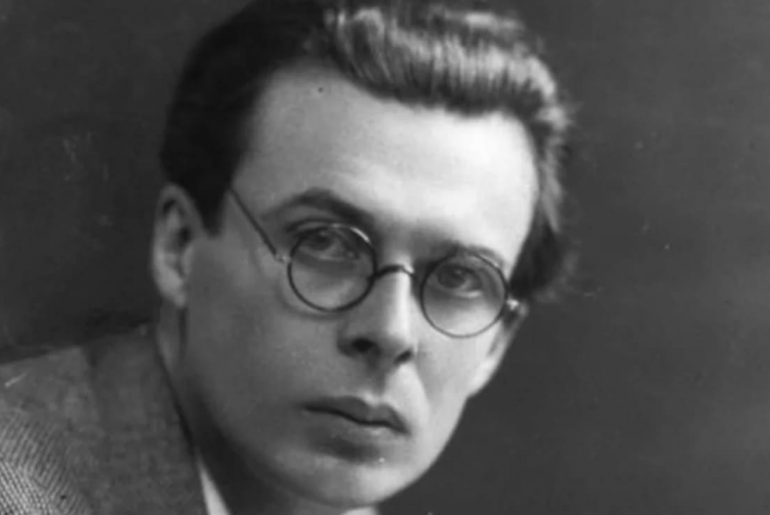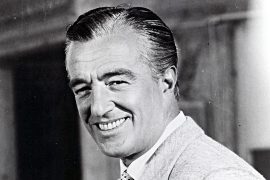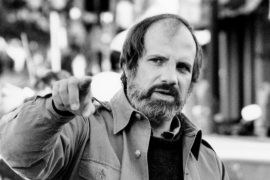The English writer ALDOUS HUXLEY is best known for his novel Brave New World (1932). The book is directed against the belief in progress. In a nightmare version of the future, HUXLEY paints a picture of an artificially created society in which people are under total control and geared solely towards prosperity. It’s about people who are created by retort and whose natural impulses are extinguished. The success of the book is unbroken to this day due to its subject matter.
In addition to Brave New World, HUXLEY also wrote numerous other works, including many novels and short stories. But he also wrote travelogues, philosophical treatises on drugs and screenplays for Hollywood.
Biography
ALDOUS HUXLEY was born in England in 1894. His grandfather was an important zoologist and one of the first supporters of Darwinism. HUXLEY’s mother died when he was 14 years old. At the age of 16 he attended the elite college Eton, where he almost lost his eyesight due to an illness, so that he was almost denied a scientific career. Since he went completely blind for a while, he learned Braille. HUXLEY studied at Oxford from 1913 to 1915, after which he published his first collection of poems, The burning wheel (1916). From 1921 HUXLEY wrote satirical novels such as Crome Yellow (1921, German Chrome Yellow), Antic hay (1923, German Fools’ Dance) and Those Barren Leaves (1925, German Parallels of Love). In the 1920s and 1930s he lived with his wife in Italy and France.
His first major work is his novel Point Counter from 1928 (German Counterpoint of Life), which also contains a portrait of the writer D.H. LAWRENCE finds. He was a good friend of HUXLEY’s and they had traveled together. In 1932, HUXLEY published the novel Brave New World, which became a global success and whose popularity has remained unbroken to this day.
During the 1930s, HUXLEY championed pacifism and helped Jewish refugees. In 1937 he moved to California, where he studied Far Eastern philosophy. He experimented with drugs and wrote The Perennial Philosophy (1945) and The Doors of Perception (1954) about them. Other novels emerged, such as the anti-utopia Ape and Essence (1948). HUXLEY has also written screenplays for Hollywood based on novels by JANE AUSTEN and CHARLOTTE BRONTË. In 1958 the commentary Brave New World Revisited appeared. HUXLEY died in Hollywood in 1963.
Literary creation
In his stories and novels, HUXLEY opposes the belief that scientific progress must always lead to good. In addition to the works of GEORGE ORWELL and H.G. WELLS count them among the classics of science fiction.
HUXLEY’s first satirical novels, Crome Yellow (1921) and Those Barren Leaves (1925), express his disappointment during the post-war period. He describes real people in English society so brilliantly and cynically that they felt offended by him. However, the novels received good reviews.
However, HUXLEY’s most important theme, which he also deals with in many essays, remains his criticism of social specialization and the rationalist belief in progress. He only presents both in his best-known novel Brave New World, which is directed against HERBERT GEORGE WELLS’ belief in progress. Like GEORGE ORWELL in 1984, which appeared in 1949, HUXLEY sketches an anti-utopia (dystopia), i. H. a nightmare version of the future. He describes the image of a dehumanized humanity in which people are under total control and which is solely geared towards prosperity:
With the help of modern application of natural science, people are bred according to recipe and exactly hierarchically standardized by assembly line retort. With the help of conditioning, they learn not to question their social status. Poverty, misery, dirt and unrest do not exist, but there is no more freedom, religion, art and imagination either. Happiness is artificially created for everyone equally, so that each individual is considered a crime. The three rebellious outsiders Bernard Marx, Helmholtz Watson and a natural-born Indian disturb the image of the artificial society.
HUXLEY describes hauntingly disillusioning images of a future automated world that is bereft of all natural impulses and against which he urgently warns.
The novel became a worldwide success. In his 1958 commentary Brave New World Revisited, HUXLEY revised his prophecies and feared that they could become reality even faster than he thought. In the age of genetic engineering in the 21st century, his work is perhaps even more relevant than when it was published.
Other works (selection)
Novels
Eyeless in Gaza (1936)
Time Must Have a Stop (1944)
The Devils of Loudun (1952)
The Genius and the Goddess (1955)
Iceland (1962, German Eiland)
What was Aldous Huxley known for?
Aldous Leonard Huxley (July 26, 1894 – November 22, 1963) was an English-born writer, whose masterpiece novel, Brave New World, depicted a future in which universal happiness is only achieved by thoroughly dehumanizing humanity.
What did Aldous Huxley believe?
He was concerned about the future of society and opposed to organized religion. He was longing for answers and meaning, and he had begun to form a spiritual belief where colour and light are central. These spiritual aspects can be seen as the beginning of Huxley’s spiritual enlightenment.
What inspired Aldous Huxley?
Here Huxley met novelist Virginia Woolf, economist John Maynard Keynes, and critics Bertrand Russell and Clive Bell — some of the most important writers and thinkers of the time. Huxley’s early exposure to the ideas of such a diverse and progressive group deeply influenced his world-view and his writing.





